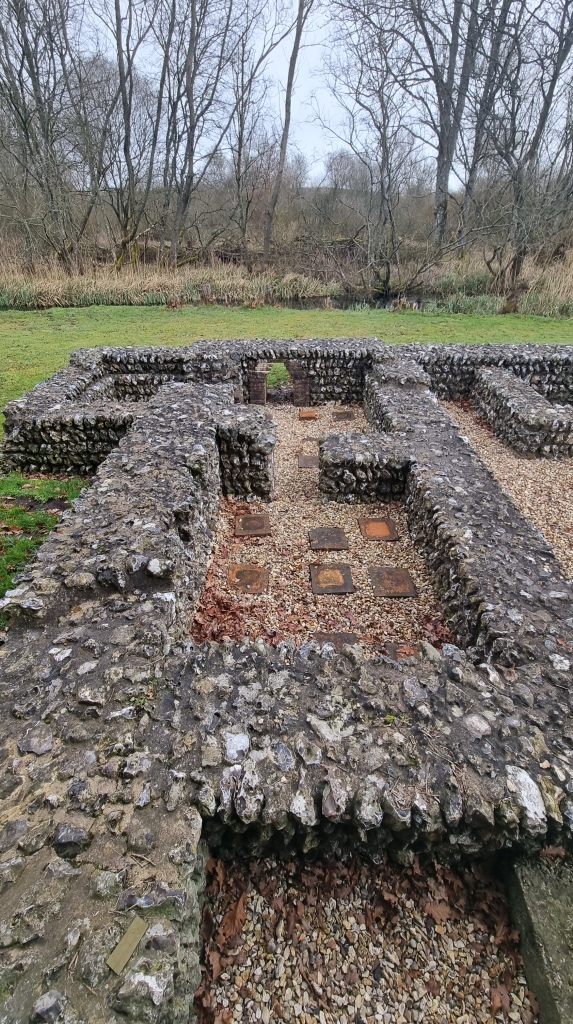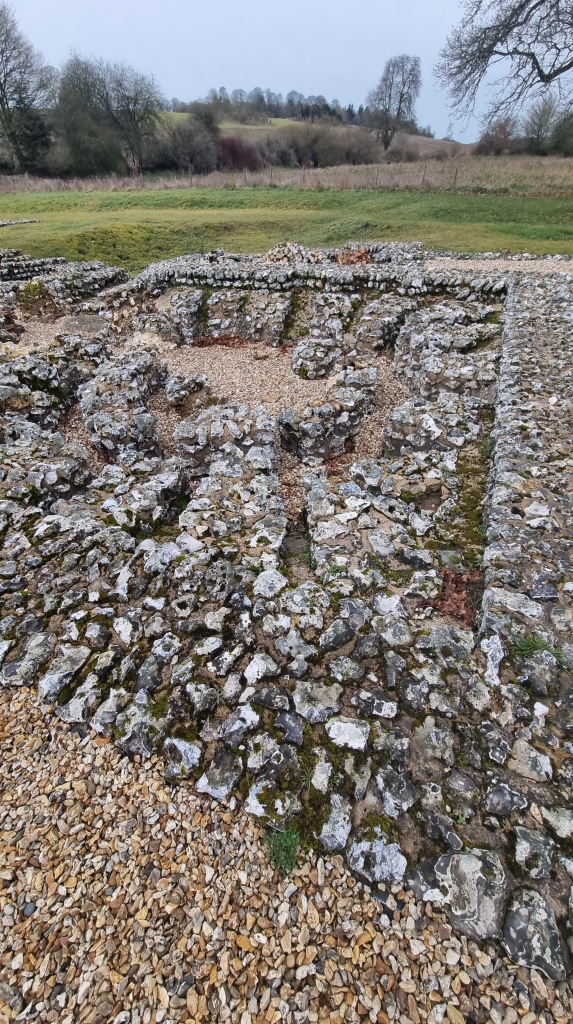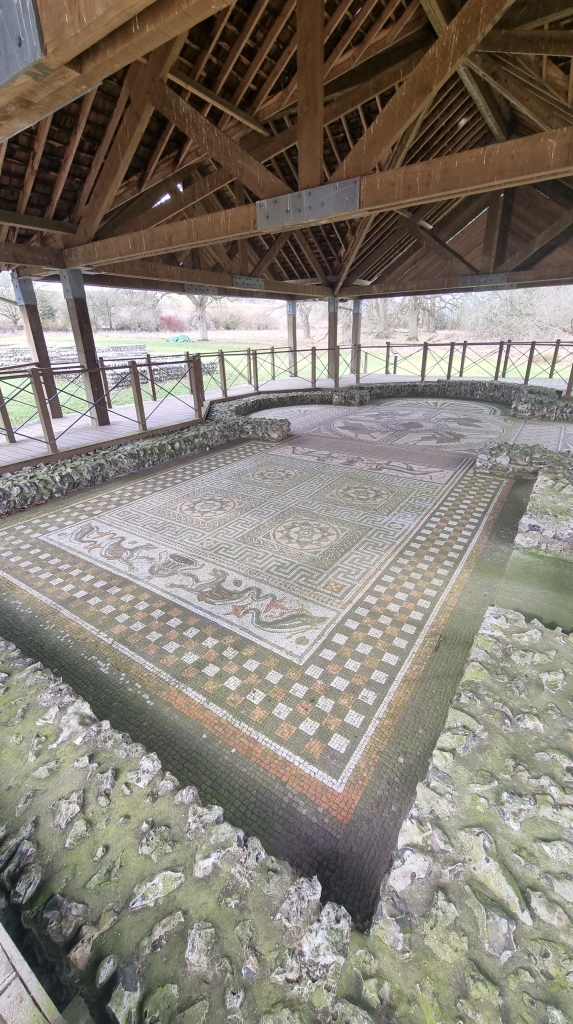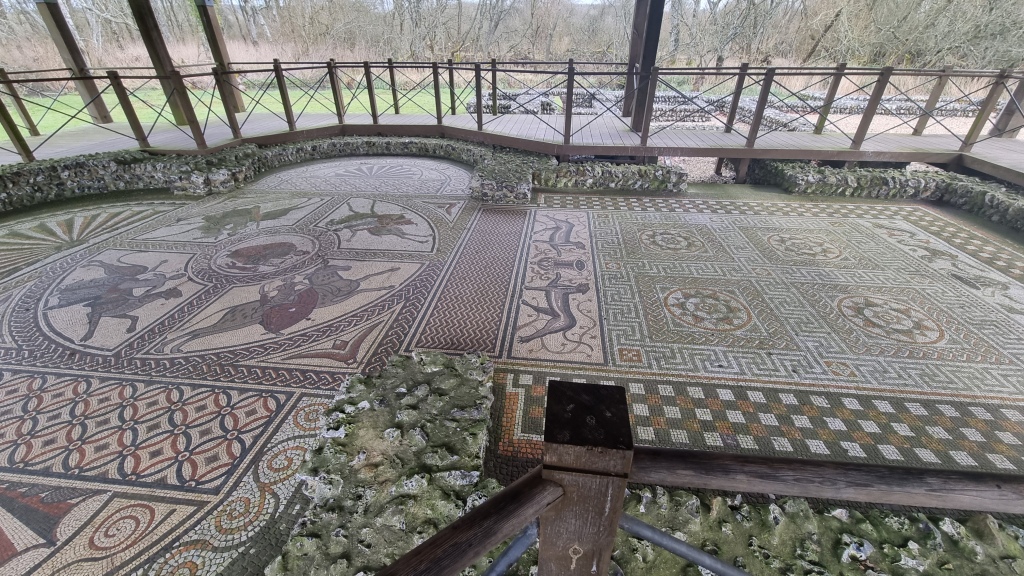Near the grounds of the Elizabethan mansion of Littlecote house which is close the historic town of Hungerford, stands a well preserved roman villa above ground in England. We’ve seen our fair share of roman villas in England, but Littlecote has turned out to be quite impressive and worth a journey. This villa incredibly has one of the only fully exposed mosaic ruins and it features the largest gatehouse ever found in a roman villa in the UK.
When the romans invaded England in AD43 in what is now, Kent, they soon built roman roads spreading west and north as they occupied the country, one small road was built here at Littlecote, and a small military garrison guarded the ever important river crossing. A few timber roundhouses were established around 60ad near the present day covered mosaic building when a bakery and brewery were added and around 170ad the first flint stone building was created. The villa went on to become a large farming estate, supplying the communities in the surrounding area, it was around AD 360, that the villa covered more than one hectare with around 60 rooms, 3 bathhouses, several mosaic floors and numerous hypocausts for heating. The villa itself is said to be built in the 1st century during the first wave of roman settlement in Britain.


We’re standing at the gatehouse; this was actually once three stories high, perhaps the grandest gatehouse in roman Britain. It was built around 290-300, the long building to our left was thought to have been a stable block and a similar building would have been on the north side extending to the river. As we have a look around, the entire courtyard was surrounded by higher stone wall and the fields that are beyond the site were used in roman times to grow crops. There used to be open lands for grazing cattle and the nearby woodlands provided foraging for pigs, timber for building and fuel for fires. There would have also veg plots both inside and outside of the courtyard. It maintained and supplied produce all over the surrounding area, In the mid 300’s the owner of this villa would have been thought to be amongst the wealthiest owners in roman Britain.
The earliest building was on the south range, it was a huge barn built in the early 3rd century but around 270ad the building was converted for residential use, you can see this by all of the internal rooms. You can make out the various rooms and have a good look at where the furnace was, to its left it would have been there changing room, where the romans would have stripped off their clothes before heading into the tepidarium, or the warm room where the bathers would have been able to massage scented oils they had made before the heading into the next room, which was the caldarium, or the hot room, it’s here you would sweat it out, then on into the frigidarium, or cold room and then finally dipping into the cold plunge bath. The bathers would finish by returning to the changing room to re moisturize and apply perfumes. The bathhouse would be like a modern day health spa, a place for the people to exercise, drink, gossip and relax. A 2nd century well still survives and is well preserved. This supplied the earlier villa house and baths.



At the end of the 4th century, the Roman Empire declined and by 410 the romans and their many armies had packed up and moved back to Rome. Most of the archaeological evidence suggests that this villa rapidly declined, parts were demolished, building materials were robbed and most of it fell into decay and was long forgotten about.
After exploring outside we take a few steps into the now covered building which was known as the orphic hall, this contains one of the finest covered displays of mosaics in England. The roman people would have walked up a few stairs into this hall and gathered up either side of the hall to look through to the arch leading into the sacrum. This remarkable hall was reminiscent of the shape to many of the later churches especially in the roman eastern empire as a triple apse design which looks similar to a three leaf clover. The three apses supported a central tower and windows on all sides and it was designed to create a well of light shining onto the mosaic below. Most of the people standing on these mosaics, perhaps praying would have understood the different depictions in the mosaic patterns and panels, although they are much less familiar to us today.



You’re drawn to the four floral patterns filled with a lotus design and surrounded with borders of Greek key or Roman Swastika pattern and all the different chaotic geometric patterns that they enjoyed to decorate. Above these there are a depiction of panthers and vines that borders it but the intricate and most impressive mosaic is at the top end of this building is just incredible to see, all in its glory.
This mosaic was firstly mentioned in 1727 by William George, who was the estate steward for Littlecote estate, it was discovered by mistake whilst digging for post holes for new fencing around a hunting lodge. Unfortunately the owner at that time Francis Popham had it reburied, possibly to avoid tourism. So many people thought it was destroyed or simply forgotten about until it was rediscovered later in 1977. Half of the tiles had survived and were since replaced by modern terracotta tiles which were helpfully modelled on a 1730 engraving by George in a museum at Oxford.

The pattern of the mosaic is centred on a figure of Orpheus, known as the musician and priest of Apollo the sun god, surrounded by four quadrants, each quadrant is a female deity, representing one of the four seasons. In the four circles you can see Persephone with a goat, Venus with a hind, Leda with a panther and Demeter with a bull. These animals or beasts in each of the scene have been interpreted as transformations of Bacchus, the son of Zeus, fleeing from the titans.. The entire sequence and depiction relates to not only the seasons but also to the cycle of birth, death and rebirth. When I was learning and reading about this it really was interesting and so exciting, art can be interpreted in so many wonderful ways and I love the roman way of telling a story through their building work.

There is so much to see, not only the fantastic remains inside the covered shelter of the mosaic but also the surroundings, being able to walk amongst the roman ruins of a site that was once busy, thriving and a community of people who would have been proud of their dwellings but you can also appreciate the space in which they built their home. This is just another reason for people to come and visit around Wiltshire; it’s got such an incredible history buried within the area aswell as many other places of interest close by.
If you liked the blog please hit that like button, watch the full video below and consider subscribing if you haven’t already.
Till Next Time!
Discover more from Pinned on Places
Subscribe to get the latest posts sent to your email.


Leave a comment